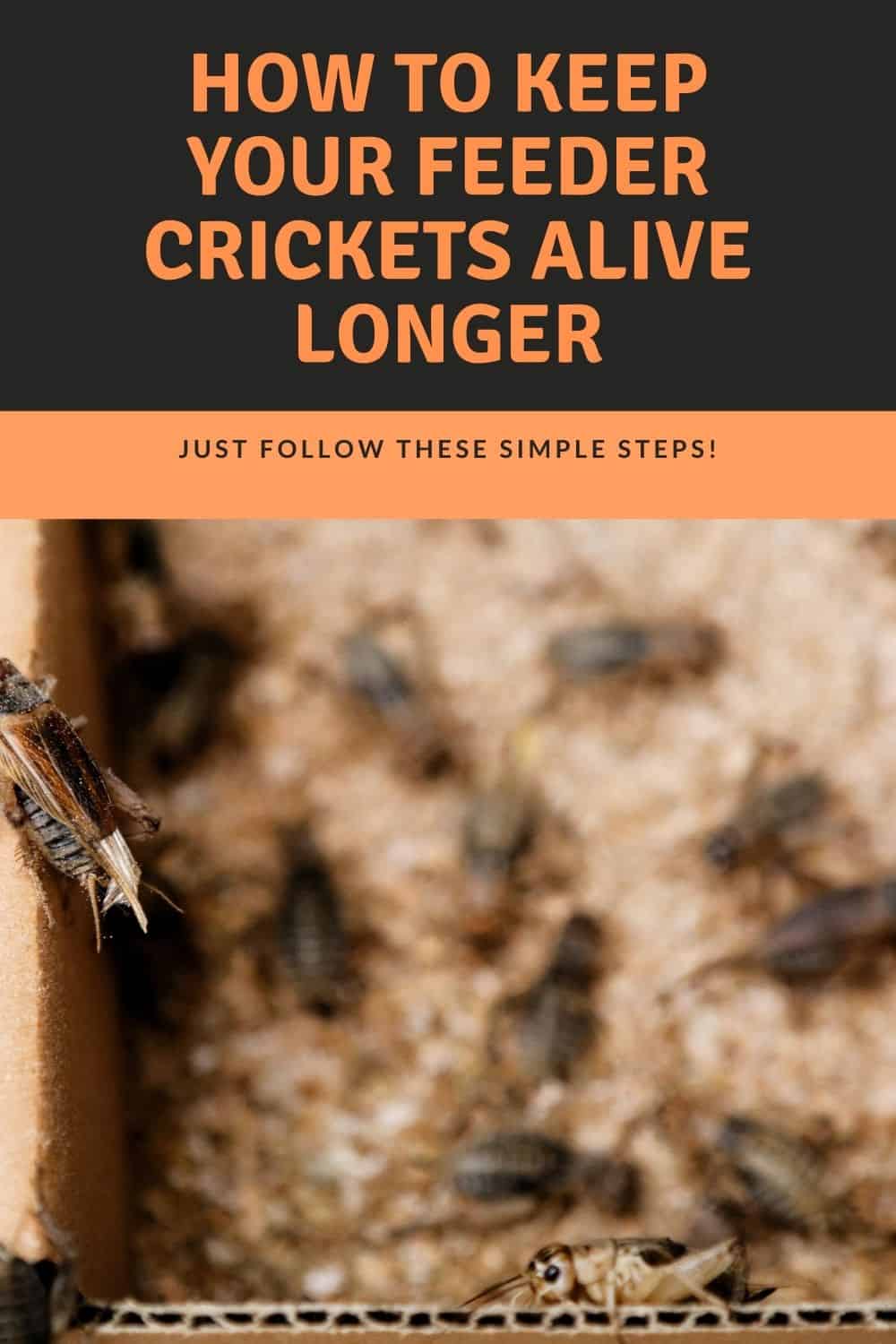
Jeffery Jago is a expert in horticulture and worm breeding. With a background in plant cultivation
Last Updated on May 4, 2021 by Jeffery Jago
Feeder crickets are a great way to keep your reptiles, amphibians, and arachnids happy. However, if you’re like most people who own these pets, you might be wondering “how can I make sure my feeders are alive for as long as possible?” Well, wonder no more! Here is our guide on how to keep your feeder crickets alive longer with some easy tips that require little-to-no effort.
The average lifespan of a feeder cricket is about a month, but with some simple tips and tricks, you can make them last as long as four months!
Crickets aren’t super high maintenance, especially when they’re just feeders and your only goal is to keep them alive for a few months.
Feeder crickets need three things to survive: food, water, and heat. However, there’s a lot of in-between the lines on that. For instance, it’s important to remember that feeder crickets will need fresh water, a suitable enclosure size for their population, and water they won’t accidentally drown in. Let’s get to it!
Keeping the temperature stable
First up is keeping a stable temperature for your crickets. You’ll want to make sure the temperature in their enclosure is at least 75 degrees Fahrenheit. You’re allowed to have small fluctuations between the ranges of 75f and 90f, no more no less. The sweet spot is going to be around 75f.
As long as you maintain these proper temperatures, your feeder crickets should be happy enough to stay alive and kickin’. Remember, heat issues will result in dead crickets really quickly, their sensitive.
If you’re struggling with keeping the heat in their enclosure, then consider using a heating pad to help provide them with warmth. These are not necessary but they can make life much easier for your little friends.
Keeping enclosure well ventilated
This is a big one, lot of people think a few holes are enough for airflow but it’s not always the case. If your using one of those “cricket keeper” type enclosures then the airflow should be enough for the small number of crickets you can put inside it. However, if you’ve got a lot of crickets and you using something like a Rubbermaid container, here’s what you need to do:
Instead of poking holes in the lid, You should cut out a large square in the middle of the Rubbermaid cover, and then staple a screen (something like a window screen or a wire mesh) to the Rubbermaid so that it sits on top of the cut-out square. The screen will act as a filter and allow air to pass through while keeping bugs out and crickets in.
This will ensure enough airflow for at least 2000 crickets to be kept inside.
It’s not the easiest thing to do, a bit of manual labor, but it should work and is worth the time for keeping your crickets alive longer!
Is the enclosure big enough?
Since we’re already talking about the enclosure itself, We should speak about its size. If your using a cricket keeper from Amazon or another store, You may have realized they are only really big enough for about 30 or so crickets at a time. That’s definitely no good if you need to keep more alive for longer.
That’s not to say cricket keepers are bad. They are fine for the small-time Lizzard owner but you will find you outgrow it fairly quickly.
If you want to cram more than just 30 crickets into the container, it’s time to get a bigger one. As we said up above, many people will opt for a Rubbermaid container that is fitted with cardboard cartons, creating “floors” and layers. This will allow you to keep upwards of 2000 crickets at a time per enclosure.
Giving your cricket population enough space is essential to keeping them alive as long as possible, as well as keeping them happy.
Make sure they get enough food
Even if you think you’re feeding your crickets enough food, You really aren’t. If you ever go to check your cricket’s food and the dish is empty, that means you aren’t giving them enough.
Crickets always need access to food or else they will quickly turn to canabalism. Obviously, this doesn’t jive well with your goal of keeping them alive as long as possible!
So with that said, crickets should always have food nearby.
The type of food you feed your crickets is also important to their survival and longevity. The best option for feeding them would be a mix of protein pellets, mealworms, oats, and wheat germ with some fruit or vegetables (like apple slices). This will provide the right nutrients they need to live longer than just giving them one thing like cricket chow.
A varied diet is important, but what’s also important is their hydration!
Keep them hydrated without drowning them
Aside from making sure, they have food, you need to make sure they always have water available. Crickets are kind of dumb in the way they will drown themselves if a water dish is slightly too deep.
To get around this, Place a wet sponge on top of a plate. You could also try a variety of different ways to make sure their water dish is always full, like using an eyedropper or baster with some sorta “sink” in the middle that will keep them from drowning but still allow for plenty of room.
Feel free to experiment. However, you will need to change the sponge every 2 days, or else it could breed bacteria that will also hurt your crickets.
Keep them clean
Keeping your enclosure clean is of the utmost importance when you want to keep them alive for as long as possible. Just like anything else, they require clean accommodations so they don’t become sick.
In order to keep them clean, you’ll need:
- -A bowl of hot water.
- -Paper towels for drying off the enclosure and dishes for food and water
- -A small hand broom
- -A small dustpan
I don’t think I need to tell you instructions for what you need to do with these things. Try not to use any soap as it’s bad for the crickets, warm water should do just fine for wiping down the enclosure if it needs it.
Remove dead crickets. Dead crickets suck, but you can’t just leave them there to rot away and breed disease. If you find a dead cricket, make sure to remove it from the enclosure and dispose of them as quickly as possible.
You should also remove any leftover fresh produce you might have given them to munch on after about 24 hours. This prevents rot and decay and mold. It also keeps away various other insects that will bother your crickets, such as carnivorous mites and annoying fruit flies (save yourself some sanity and don’t let fruit flies take over your house!)
Conclusion: By doing all these things, not only will you be able to keep your feeder crickets alive longer, but they’ll live healthier and happier lives and the most important part, LONG lives.
TL;DR:
- -Maintaining a steady temperature is the most important part of your enclosure. The best place to put them in during the day would be somewhere that gets indirect sunlight, like on top of an old bookshelf or cabinet where they can’t get direct sun and you can adjust them by moving it closer as needed. At night time, when temperatures drop below 70F (21C), make sure to provide some form of heat for their enclosure such as with a heating pad under half of the enclosure so they’re not sitting directly on it, but still close enough to feel its warmth.
- -An absolute must! Crickets need water just like any other mammal does and without it, their life expectancy goes down significantly lower than 24 hours. Don’t let your crickets get too thirsty – make sure they have fresh water every day in the form of a sponge, not a deep dish.
- -They will die if there is no air circulation in the enclosure. You need vents on both sides or a large hole In the top for a constant flow of oxygen that won’t allow them to suffocate or get wet from condensation dripping down off the lid onto them. (that can make them drown, funnily enough, very sensitive creatures)
- -Crickets require food just like any other animal does because it’s how they get all essential nutrients to survive. The type of food you feed them will alter how fast they grow and if their lifespan is shortened or lengthened, so it’s important to know what’s best for your crickets
- -You need to clean up any messes that are created by the crickets like droppings that have high ammonia content! If not cleaned up regularly, these piles will start decomposing on their own which releases various deadly toxins.

